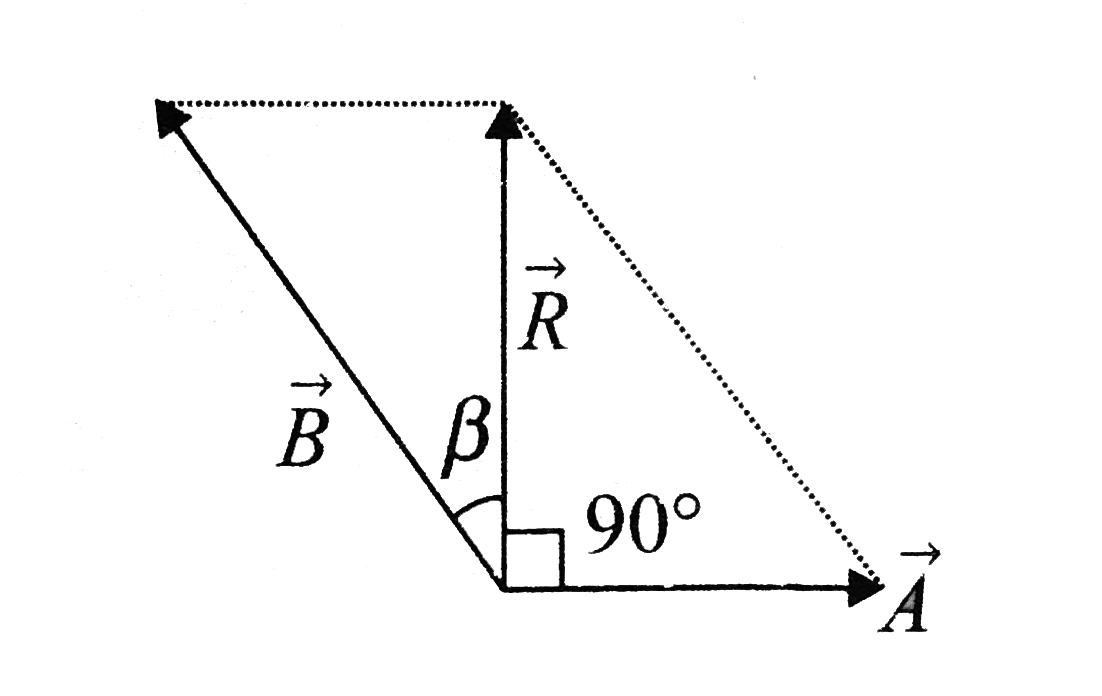The ratio of maximum and minimum magnitudes of the resultant of two vectors →a and →b is 3:1. Now, |→a| is equal to
∣∣→b∣∣
2∣∣→b∣∣
3∣∣→b∣∣
4∣∣→b∣∣
The correct Answer is:B
To solve the problem, we need to find the magnitude of vector →a given that the ratio of the maximum and minimum magnitudes of the resultant of two vectors →a and →b is 3:1.
1. Understanding the Resultant of Two Vectors:
The resultant R of two vectors →a and →b can be expressed using the formula:
R=√|→a|2+|→b|2+2|→a||→b|cosθ
where θ is the angle between the two vectors.
2. Finding Maximum Resultant:
The maximum resultant occurs when cosθ=1 (i.e., when the vectors are in the same direction, θ=0∘):
Rmax=|→a|+|→b|
3. Finding Minimum Resultant:
The minimum resultant occurs when cosθ=−1 (i.e., when the vectors are in opposite directions, θ=180∘):
Rmin=||→a|−|→b||=||a|−|b||
4. Setting Up the Ratio:
According to the problem, the ratio of the maximum to minimum resultant is given as:
RmaxRmin=31
Substituting the expressions for Rmax and Rmin:
|→a|+|→b|||→a|−|→b||=3
5. Cross-Multiplying:
Cross-multiplying gives:
|→a|+|→b|=3⋅||→a|−|→b||
6. Considering Cases:
We can consider two cases based on the magnitudes of |→a| and |→b|:
- Case 1: |→a|≥|→b|
|→a|+|→b|=3(|→a|−|→b|)
Simplifying this:
|→a|+|→b|=3|→a|−3|→b|
4|→b|=2|→a|
|→a|=2|→b|
- Case 2: |→a|<|→b|
|→a|+|→b|=3(|→b|−|→a|)
This case will lead to a contradiction since it will imply |→a| cannot be less than |→b| based on the ratio given.
7. Conclusion:
Thus, from Case 1, we conclude that:
|→a|=2|→b|
Final Answer:
The magnitude of vector →a is 2|→b|.
The resultant R of two vectors →a and →b can be expressed using the formula:
R=√|→a|2+|→b|2+2|→a||→b|cosθ
where θ is the angle between the two vectors.
The maximum resultant occurs when cosθ=1 (i.e., when the vectors are in the same direction, θ=0∘):
Rmax=|→a|+|→b|
The minimum resultant occurs when cosθ=−1 (i.e., when the vectors are in opposite directions, θ=180∘):
Rmin=||→a|−|→b||=||a|−|b||
According to the problem, the ratio of the maximum to minimum resultant is given as:
RmaxRmin=31
Substituting the expressions for Rmax and Rmin:
|→a|+|→b|||→a|−|→b||=3
Cross-multiplying gives:
|→a|+|→b|=3⋅||→a|−|→b||
We can consider two cases based on the magnitudes of |→a| and |→b|:
- Case 1: |→a|≥|→b|
|→a|+|→b|=3(|→a|−|→b|)
Simplifying this:
|→a|+|→b|=3|→a|−3|→b|
4|→b|=2|→a|
|→a|=2|→b|
|→a|+|→b|=3(|→b|−|→a|)
This case will lead to a contradiction since it will imply |→a| cannot be less than |→b| based on the ratio given.
Thus, from Case 1, we conclude that:
|→a|=2|→b|
The magnitude of vector →a is 2|→b|.
Topper's Solved these Questions
- BASIC MATHEMATICS & VECTORSBOOK - VMC MODULES ENGLISHCHAPTER - BASIC MATHEMATICS & VECTORSEXERCISE - Efficient
50 Videos
- BASIC MATHEMATICS & VECTORSBOOK - VMC MODULES ENGLISHCHAPTER - BASIC MATHEMATICS & VECTORSEXERCISE - Impeccable
50 Videos
- BASIC MATHEMATICS & VECTORSBOOK - VMC MODULES ENGLISHCHAPTER - BASIC MATHEMATICS & VECTORSEXERCISE - Impeccable
50 Videos
- CAPACITORSBOOK - VMC MODULES ENGLISHCHAPTER - CAPACITORSEXERCISE - JEE Advance ( Archive ) LEVEL 48
1 Videos
Similar Questions
Write an expression for magnitude of the resultant vector .→R. of two vectors →Aand→B acting at a point. When will this resultant vector .→R. be maximum ?
View SolutionWhat are the properties fo two vectors →aand→b such that →a+→b=→a−→b ?
View SolutionFind the angle between two vectors →a and →b, if ∣∣→a×→b∣∣=→a.→b .
View SolutionThe resultant and dot product of two vectors →aand→b is equal to the magnitude of →a. Show that when the vector →a is doubled , the new resultant is perpendicular to →b .
View Solutiona, b are the magnitudes of vectors →a & →b. If →a×→b=0 the value of →a.→b is
View SolutionIf →a,→b,and→c are mutually perpendicular vectors of equal magnitudes, then find the angle between vectors →aand→a+→b+→c.
View SolutionIf a vector →A is parallel to another vector →B then the resultant of the vector →A×→B will be equal to
View SolutionThe resultant of two vectors →A and →B is perpendicular to the vector →A and its magnitudes is equal to half of the magnitudes of vector →B (figure). The angle between →A and →B is

View SolutionTwo vectors →P and →Q are added, the magnitude of resultant is 15 units. If →Q is reversed and added to →P resultant has a magnitude √113 units. The resultant of →P and a vector perpendicular →P and equal in magnitude to→Q has a magnitude
View SolutionThe resultant of two vectors →P and →Q is →R. If →Q is doubled then the new resultant vector is perpendicular to →P. Then magnitude of →R is :-
View Solution
